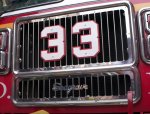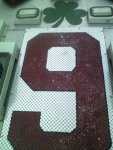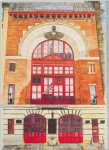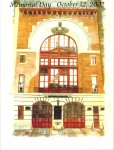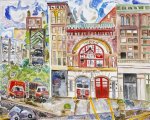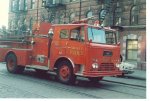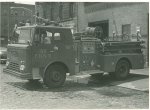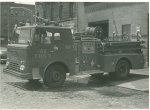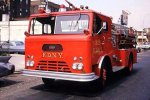You are using an out of date browser. It may not display this or other websites correctly.
You should upgrade or use an alternative browser.
You should upgrade or use an alternative browser.
FDNY and NYC Firehouses and Fire Companies - 2nd Section
- Thread starter mack
- Start date
WARD LAFRANCE FIRE BRANDS




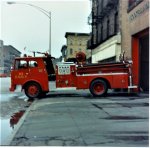
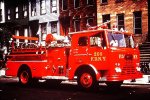
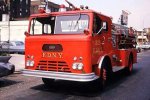
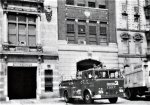
NYC Firenet Thread - WLF rigs
3511
Aug 21, 2013
"When the WLF Firebrands went into service in1960 they were nicknamed "The Pagoda" by the firefighters because the cab looked like it had been designed in Chinatown. This was not a popular buy for the men. They felt it a step back in the quality of equipment, as they had with the purchase of the FWD wooden aerials in 1955. They preferred the C Model Mack's that had entered the job beginning in 1958.
G-man is correct in their use as replacements for the older rigs. E42 got one, retiring its 1941 Mack "L", which they had received from the factory and was still going strong after nineteen years of front line service. Some Firebrands replaced older WLF's (E40, up the street from my high school on Amsterdam Ave.) or the last of the 1947 "L"'s (E46, 82) still working in busy areas. After the Firebrands, I don't believe there were any more pre -war pumpers as front line rigs, although some remained as 2d piece hose wagons for a few years.
WLF's were never very popular among the firefighters. The pumpers and hose wagons of the late 1930's were considered to be junk, hard to steer and always breaking down. They were no match for the Mack and Ahrens-Fox models of that era. The post-WWII WLF's were considered "lightweights", less durable than the Mack "L" and "B"models and the American LaFrance cab forwards. In fact, they WERE lighter, with part of the body frame made of wood. Their redeeming feature was the booster tank, the first rigs in the FDNY to have them. No more hooking up and long stretches just to knock down a car, brush, or "EL" fire.
In fact, the 1950's WLF's proved quite durable. E79 had their 1951 model for eighteen years. Although located on the periphery of the Bronx' busy areas, that rig saw a lot of fire duty as 79 went south of Fordham Road and interchanged with E50.
The WLF CD pumper fleet was a lifesaver for the FDNY. Purchased by the federal government in the aftermath of WWII, they were supposed to augment the Department in case air raids like the London Blitz. With the development of jet aircraft, missiles, and nuclear weapons the concept was obsolete by the time the CD's arrived. They mostly sat around in quarters for a decade when they reverted to City ownership. By 1965, they were like horseshit in the old days, seen everywhere around the city as spares and even front line apparatus. They bridged the gap until the new Macks arrived in the late 1960's."
Bronx72
Aug 31, 2013
"E82 received their 1960 WLF Firebrand on 9/28/60. It was in service until 82 got one of the first Mack CF's (#1072, but maybe not the first one put in service) in early Dec. 1968. That means that the WLF was at 82 for [i]8 years.[/i] During that time here are the Runs for 82, starting in 1961: 2648, 2733, 3051, 4612, 5137, 6234, 6659, 9111. The last year, 1968, vaulted E82 to #1 in the city for Runs, which includes all units, not just Engines. The total runs for the 8-year period is 40,185! While we can presume that the truck missed some runs due to maintenance downtime, it was not affected by interchanges, and the total is remarkable. It's a wonder that it was able to see service at E249 afterwards for over a year until 249 got their 1970 Mack."
guitarman314
Sep 4, 2013
"Those fugly 1960 Ward LaFarnce Firebrands held up pretty well. Engine 46 had one and so did busy Brooklyn E209, E216, E217 and E235."

 www.nycfire.net
www.nycfire.net

Ward LaFrance Truck Corp. was a fire apparatus builder located in Elmira Heights, New York.
Historyedit | edit source
Addison Ward LaFrance (1884-1972) was a son of Asa LaFrance and nephew of Truckson LaFrance, founders of American LaFrance. He started working for the family business in the early 1900s, until he and a partner formed an auto sales agency in 1905. In 1918, LaFrance entered the truck manufacturing business. LaFrance trucks were assembled using components purchased from independent suppliers and LaFrance-built cabs and bodies. The name was changed to Ward LaFrance Truck Co. shortly after.
In 1930, despite the presence of nearby American LaFrance, WLF entered the fire apparatus market. Fire trucks became a large part of the company's business, and in 1937, Ward LaFrance secured an order from FDNY. Trucks were built on custom Ward LaFrance apparatus. During the Second World War, WLF built wreckers, bridge-layers and military fire trucks for the US military. Ward LaFrance sold to the company to Great American Industries in 1942.
As with many companies, the postwar years saw a boom in fire apparatus production. The company built its first aerial truck tractor for the Buffalo Fire Department in 1951. Its first aerial truck was built in 1955 using a 65-foot ladder purchased from Maxim Motor Company, and its conventional fire chassis were restyled in 1957. In 1959, the Firebrand cabover chassis was introduced. And in 1962, the Mark I, later renamed the Ambassador, was introduced. This became the "look" of WLF for the next several years. Aerial ladder assemblies were purchased from Grove and Pierre Thibault, and platform trucks from Hi-Ranger.
Owned by Talcott National since 1965, WLF was sold to a partnership that also owned Maxim in 1976. Operations between the two companies were merged, but production in Elmira Heights stopped in 1979 and WLF was no more.
.
Ward LaFrance pictures
 wardlafrance.com
wardlafrance.com








NYC Firenet Thread - WLF rigs
3511
Aug 21, 2013
"When the WLF Firebrands went into service in1960 they were nicknamed "The Pagoda" by the firefighters because the cab looked like it had been designed in Chinatown. This was not a popular buy for the men. They felt it a step back in the quality of equipment, as they had with the purchase of the FWD wooden aerials in 1955. They preferred the C Model Mack's that had entered the job beginning in 1958.
G-man is correct in their use as replacements for the older rigs. E42 got one, retiring its 1941 Mack "L", which they had received from the factory and was still going strong after nineteen years of front line service. Some Firebrands replaced older WLF's (E40, up the street from my high school on Amsterdam Ave.) or the last of the 1947 "L"'s (E46, 82) still working in busy areas. After the Firebrands, I don't believe there were any more pre -war pumpers as front line rigs, although some remained as 2d piece hose wagons for a few years.
WLF's were never very popular among the firefighters. The pumpers and hose wagons of the late 1930's were considered to be junk, hard to steer and always breaking down. They were no match for the Mack and Ahrens-Fox models of that era. The post-WWII WLF's were considered "lightweights", less durable than the Mack "L" and "B"models and the American LaFrance cab forwards. In fact, they WERE lighter, with part of the body frame made of wood. Their redeeming feature was the booster tank, the first rigs in the FDNY to have them. No more hooking up and long stretches just to knock down a car, brush, or "EL" fire.
In fact, the 1950's WLF's proved quite durable. E79 had their 1951 model for eighteen years. Although located on the periphery of the Bronx' busy areas, that rig saw a lot of fire duty as 79 went south of Fordham Road and interchanged with E50.
The WLF CD pumper fleet was a lifesaver for the FDNY. Purchased by the federal government in the aftermath of WWII, they were supposed to augment the Department in case air raids like the London Blitz. With the development of jet aircraft, missiles, and nuclear weapons the concept was obsolete by the time the CD's arrived. They mostly sat around in quarters for a decade when they reverted to City ownership. By 1965, they were like horseshit in the old days, seen everywhere around the city as spares and even front line apparatus. They bridged the gap until the new Macks arrived in the late 1960's."
Bronx72
Aug 31, 2013
"E82 received their 1960 WLF Firebrand on 9/28/60. It was in service until 82 got one of the first Mack CF's (#1072, but maybe not the first one put in service) in early Dec. 1968. That means that the WLF was at 82 for [i]8 years.[/i] During that time here are the Runs for 82, starting in 1961: 2648, 2733, 3051, 4612, 5137, 6234, 6659, 9111. The last year, 1968, vaulted E82 to #1 in the city for Runs, which includes all units, not just Engines. The total runs for the 8-year period is 40,185! While we can presume that the truck missed some runs due to maintenance downtime, it was not affected by interchanges, and the total is remarkable. It's a wonder that it was able to see service at E249 afterwards for over a year until 249 got their 1970 Mack."
guitarman314
Sep 4, 2013
"Those fugly 1960 Ward LaFarnce Firebrands held up pretty well. Engine 46 had one and so did busy Brooklyn E209, E216, E217 and E235."

Ward LaFrance rigs
When the WLF Firebrands went into service in1960 they were nicknamed "The Pagoda" by the firefighters because the cab looked like it had been designed in Chinatown. This was not a popular buy for the men. They felt it a step back in the quality of equipment, as they had with the purchase of the...
 www.nycfire.net
www.nycfire.net

Ward LaFrance Truck Corp. was a fire apparatus builder located in Elmira Heights, New York.
Historyedit | edit source
Addison Ward LaFrance (1884-1972) was a son of Asa LaFrance and nephew of Truckson LaFrance, founders of American LaFrance. He started working for the family business in the early 1900s, until he and a partner formed an auto sales agency in 1905. In 1918, LaFrance entered the truck manufacturing business. LaFrance trucks were assembled using components purchased from independent suppliers and LaFrance-built cabs and bodies. The name was changed to Ward LaFrance Truck Co. shortly after.
In 1930, despite the presence of nearby American LaFrance, WLF entered the fire apparatus market. Fire trucks became a large part of the company's business, and in 1937, Ward LaFrance secured an order from FDNY. Trucks were built on custom Ward LaFrance apparatus. During the Second World War, WLF built wreckers, bridge-layers and military fire trucks for the US military. Ward LaFrance sold to the company to Great American Industries in 1942.
As with many companies, the postwar years saw a boom in fire apparatus production. The company built its first aerial truck tractor for the Buffalo Fire Department in 1951. Its first aerial truck was built in 1955 using a 65-foot ladder purchased from Maxim Motor Company, and its conventional fire chassis were restyled in 1957. In 1959, the Firebrand cabover chassis was introduced. And in 1962, the Mark I, later renamed the Ambassador, was introduced. This became the "look" of WLF for the next several years. Aerial ladder assemblies were purchased from Grove and Pierre Thibault, and platform trucks from Hi-Ranger.
Owned by Talcott National since 1965, WLF was sold to a partnership that also owned Maxim in 1976. Operations between the two companies were merged, but production in Elmira Heights stopped in 1979 and WLF was no more.
.
Ward LaFrance pictures
Photo Gallery
Attachments
Last edited:
- Joined
- Aug 29, 2008
- Messages
- 2,487
In the article(s) about these '60 Ward pumpers, the '55 FWD 75' aerials were also mentioned. In Queens, E297 had the Ward and their housemates L130 had a FWD. At the same time the identical combination of rigs were at E325 & L163. Can't think of any other houses that had the two together.
- Joined
- Aug 29, 2008
- Messages
- 2,487
Yes they did. You beat me to the post as I thought of it, lolEngine 331 and Ladder 173 had the WLF and FWD rigs and if I can remember, they had them at the same time.
- Joined
- Sep 25, 2013
- Messages
- 1,000
Battalion 37 covers the Bushwick neighborhood of Brooklyn. Originally it was the 7th District of the Brooklyn Fire Department, becoming Battalion 7 of Brooklyn and Queens in the newly consolidated FDNY and shortly thereafter becoming the original Battalion 27. In 1906 the battalion was renumbered Battalion 37. A second section (37-2) was established in 1968, becoming Battalion 28 within a year. The contiguous neighborhoods of Ridgewood and Glendale in Queens have been covered by Battalion 37 in previous decades with Engine 286 and Ladder 135 being part of the Bushwick battalion for nearly 40 years from 1913 to 1951.
Brooklyn FD
FDNY Brooklyn & Queens
FDNY
Brooklyn FD
| District Engineer 7 | Organized | 112 Siegel St, Brooklyn | 1885 | with Brooklyn FD Engine 18 | |
| District Engineer 7 | Relocated | 43 (55) Morgan Ave, Brooklyn | 1896 | with Brooklyn FD Engine 37 | |
| District Engineer 7 | Annexed | as Battalion 7 FDNY Brooklyn | 1898 |
FDNY Brooklyn & Queens
| Battalion 7 | Organized | 43 (55) Morgan Ave, Brooklyn | 1898 | with Engine 37 FDNY Brooklyn, from Brooklyn FD District Engineer 7 | |
| Battalion 7 | Relocated | 650 Hart St, Brooklyn | 1898 | with Engine 18 FDNY Brooklyn | |
| Battalion 7 | Renumbered | as Battalion 27 FDNY | 1898 |
FDNY
| Battalion 27 | Organized | 650 Hart St, Brooklyn | 1898 | with Engine 18 Brooklyn, from Battalion 7 FDNY Brooklyn | |
| Battalion 27 | Renumbered | as Battalion 37 | 1906 |
| Battalion 37 | Reorganized | 650 Hart St, Brooklyn | 1906 | with Engine 118, from Battalion 27 | |
| Battalion 37 | Relocated | 836 Quincy St, Brooklyn | 1949 | with Engine 222 | |
| Battalion 37 | New Station | 32 Ralph Ave, Brooklyn | 1973 | with Engine 222 | |
| Battalion 37 | Temporary | 25 Rockaway Ave, Brooklyn | 2001 | with Engine 233 | |
| Battalion 37 | Renovated | 32 Ralph Ave, Brooklyn | 2002 | with Engine 222 |
| Battalion 37-2 | Organized | 836 Quincy St, Brooklyn | 1968 | with Engine 222 | |
| Battalion 37-2 | Disbanded | to reorganize Battalion 28 | 1969 |
Last edited:
- Joined
- Sep 25, 2013
- Messages
- 1,000
Companies in Battalion 37Battalion 37 covers the Bushwick neighborhood of Brooklyn. Originally it was the 7th District of the Brooklyn Fire Department, becoming Battalion 7 of Brooklyn and Queens in the newly consolidated FDNY and shortly thereafter becoming the original Battalion 27. In 1906 the battalion was renumbered Battalion 37. A second section (37-2) was established in 1968, becoming Battalion 28 within a year. The contiguous neighborhoods of Ridgewood and Glendale in Queens have been covered by Battalion 37 in previous decades with Engine 286 and Ladder 135 being part of the Bushwick battalion for nearly 40 years from 1913 to 1951.
Brooklyn FD
District Engineer 7 Organized 112 Siegel St, Brooklyn 1885 with Brooklyn FD Engine 18 District Engineer 7 Relocated 43 (55) Morgan Ave, Brooklyn 1896 with Brooklyn FD Engine 37 District Engineer 7 Annexed as Battalion 07 FDNY Brooklyn 1898
FDNY Brooklyn & Queens
Battalion 7 Organized 43 (55) Morgan Ave, Brooklyn 1898 with Engine 37 FDNY Brooklyn, from Brooklyn FD District Engineer 7 Battalion 7 Relocated 650 Hart St, Brooklyn 1898 with Engine 18 FDNY Brooklyn Battalion 7 Renumbered as Battalion 27 FDNY 1898
FDNY
Battalion 27 Organized 650 Hart St, Brooklyn 1898 with Engine 18 Brooklyn, from Battalion 7 FDNY Brooklyn Battalion 27 Renumbered as Battalion 37 1906
Battalion 37 Reorganized 650 Hart St, Brooklyn 1906 with Engine 118, from Battalion 27 Battalion 37 Relocated 836 Quincy St, Brooklyn 1949 with Engine 222 Battalion 37 New Station 32 Ralph Ave, Brooklyn 1973 with Engine 222 Battalion 37 Temporary 25 Rockaway Ave, Brooklyn 2001 with Engine 233 Battalion 37 Renovated 32 Ralph Ave, Brooklyn 2002 with Engine 222
Battalion 37-2 Organized 836 Quincy St, Brooklyn 1968 with Engine 222 Battalion 37-2 Disbanded to reorganize Battalion 28 1969
| 1885 - 1887 | District Engineer 7 | E13 | E17 | E18 | ||||||||
| 1887 - 1889 | District Engineer 7 | E16 | E17 | E18 | L8 | |||||||
| 1889 - 1895 | District Engineer 7 | E17 | E18 | E22 | L8 | |||||||
| 1895 - 1897 | District Engineer 7 | E17 | E18 | E22 | E37 | L8 | ||||||
| 1897 - 1898 | District Engineer 7 | E17 | E18 | E22 | E37 | E52 | L8 | L12 | ||||
| 1898 - 1900 | Battalion 27 | E18 | E22 | E37 | E52 | L8 | L12 | |||||
| 1900 - 1906 | Battalion 27 | E118 | E122 | E137 | E152 | L58 | L62 | |||||
| 1906 - 1908 | Battalion 37 | E117 | E118 | E122 | L62 | |||||||
| 1908 - 1909 | Battalion 37 | E117 | E118 | E122 | E171 | L62 | L74 | |||||
| 1909 - 1913 | Battalion 37 | E118 | E122 | E171 | L62 | L74 | ||||||
| 1913 - 1941 | Battalion 37 | E218 | E222 | E271 | E277 | E286 | L112 | L124 | L135 | |||
| 1941 - 1951 | Battalion 37 | E218 | E222 | E271 | E277 | E286 | L124 | L135 | ||||
| 1951 - 1965 | Battalion 37 | E214 | E217 | E222 | E233 | E252 | E277 | L111 | L112 | |||
| 1965 - 1968 | Battalion 37 | E214 | E222 | E252 | E277 | L111 | L112 | |||||
| 1968 - 1972 | Battalion 37 | E217 | E217-2 | E222 | E227 | L123 | ||||||
| 1972 - 1975 | Battalion 37 | E217 | E222 | E227 | L123 | |||||||
| 1975 - 1985 | Battalion 37 | E222 | E233 | E252 | L175 | |||||||
| 1985 - 1987 | Battalion 37 | E222 | E233 | E252 | L176 | |||||||
| 1987 - 1988 | Battalion 37 | E222 | E227 | E233 | E252 | L176 | ||||||
| 1988 - 1989 | Battalion 37 | E222 | E233 | E252 | L176 | |||||||
| 1989 - 1997 | Battalion 37 | E214 | E222 | E252 | E277 | L111 | L112 | |||||
| 1997 - | Battalion 37 | E214 | E222 | ES252 | E277 | L111 | L112 |
Last edited:
I think E 164 and L 84 might have had a WLF Firebrand and a 75 ft FWD in the house at the same time.In the article(s) about these '60 Ward pumpers, the '55 FWD 75' aerials were also mentioned. In Queens, E297 had the Ward and their housemates L130 had a FWD. At the same time the identical combination of rigs were at E325 & L163. Can't think of any other houses that had the two together.
- Joined
- Aug 29, 2008
- Messages
- 2,487
Mack, thanks. I wouldn't even have ventured that guess.
- Joined
- Mar 3, 2007
- Messages
- 1,608
173's ALF tiller looked great in person. Thanks for posting the picture!
Last edited:

